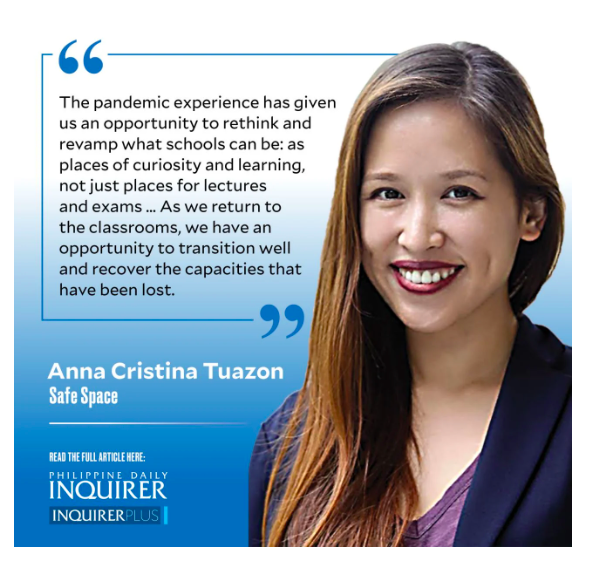Helping kids return to face-to-face
Over 10,000 schools now offer face-to-face (F2F) options for their students, ranging from voluntary pilot classes to full-time mandatory classes. We have been stable at alert level 1 for quite some time now and there is a strong urge to immediately return back to “normal.” However, the success of such a return is contingent on how much we pay attention to proper transitions. Schools play a big role in ensuring effective and safe transitions for their students: from paced and gradual re-entry back to campus to transitory options such as hybrid classes. Parents also have an even bigger part in getting their kids ready to—pardon the pun—face the world.
Physical health and safety will most likely be the dominating factor in parents’ decision to letting their kids return to campus. COVID-19 vaccinations are now available for children as young as five and this should help parents feel more confident in sending off their kids. Schools that demonstrate seriousness in retrofitting their facilities to promote health and safety will also help to assure parents. Beyond physical environments, schools are also in the best position to teach and habituate children toward proper hygiene and sanitation in a post-COVID world. To prepare for the start of F2F, parents can also start children on playful practice drills and roleplays, so they can master hygiene protocols and safe interactions with their classmates. Don’t forget that we will also need to transition to waking up earlier due to travel time—start transitioning kids to an earlier sleep schedule to minimize tantrums.
Social skills have generally regressed in the last two years due to restricted opportunities for varied social skills practice. What works online may not always work offline. Many have mastered communicating through messages but may feel much less confident with oral communication. Some kids may also suffer from heightened social anxiety, as they are no longer able to mute themselves or “turn off video” as was the case in remote learning. Some kids, meanwhile, are no longer familiar or comfortable with offline or nonscreen play. Schools should be mindful of such regressions and allow students to re-learn these social skills. Even before the pandemic, I often advocate that schools should be explicitly teaching socioemotional skills and not just assume that kids will learn this intuitively without any help. What would this look like? For example, there should be explicit instructions and guidelines on the process of group work, not just on the expected output. Group work is a common source of frustration among students mostly because they have not been taught exactly how to delegate and divide tasks equitably and effectively, how to negotiate with each other, how to motivate their group mates, or how to provide and receive feedback. Another source of social pressure in schools is the cafeteria problem. Lunchtime can be anxiety-inducing for some students due to not knowing who to sit with or how to approach their classmates at a table. In fact, this used to be one of my safety assessment questions for children: “Who do you sit with at lunch?” This helps me gauge the child’s social world at school and whether the child feels socially safe, has a sense of belongingness, and has friends they can rely on. How food halls or cafeterias are set up makes a difference in how intimidating it can be: Scarcity of seating promotes territoriality and cliques while eating in your seat at the classroom can limit opportunities for spontaneous socialization (and spending time with friends who are not in your class). We should keep children not just physically safe but socially safe as well.
Remote or online learning has changed how children attend and focus. Attention span has gotten shorter and distractibility has increased. Multitasking (or multi-tabbing) had become the norm and focusing on one thing at a time has become physically painful. For schools that have yet to begin the transition, strongly consider designing in-person classroom experiences that foster high stimulation and engagement. Passive listening to lectures is not the best way to start the transition to classrooms. Involve as many senses as possible and get them moving. Allow teachers to get as creative as possible and employ teaching modalities they could not do online. Design immersive and experiential activities. The pandemic experience has given us an opportunity to rethink and revamp what schools can be: as places of curiosity and learning, not just places for lectures and exams.
The sudden shift to remote learning two years ago has created frustrations and anxieties among parents and children. This time around, as we return to the classrooms, we have an opportunity to transition well and recover the capacities that have been lost.
——————
Disclaimer: The comments uploaded on this site do not necessarily represent or reflect the views of management and owner of Cebudailynews. We reserve the right to exclude comments that we deem to be inconsistent with our editorial standards.

